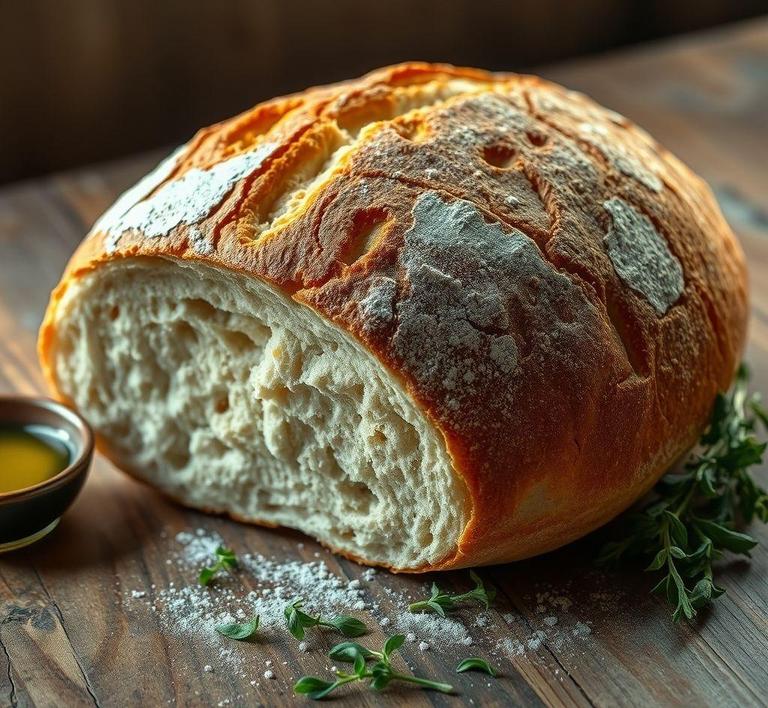If you’ve ever bought a loaf of delicious Italian bread and ended up with more than you could finish in one sitting, you might have wondered whether you could refreeze it for later. The good news is, yes, you can refreeze Italian bread! But before you do, it’s important to understand the best practices to preserve its soft, fresh texture and prevent it from becoming dry or tough. In this guide, we’ll walk you through how to properly store, thaw, and refreeze Italian bread so you can enjoy it just like new, even after it’s been frozen. Whether you’re prepping for a big meal or just want to save leftovers, this step-by-step guide will make sure your bread stays as tasty as the day you bought it.
Can You Refreeze Italian Bread?

When it comes to refreezing Italian bread, the short answer is: yes, you can, but there are important considerations to keep in mind to ensure safety and quality.
Italian bread typically has a crunchy crust and a moist, airy interior. Once frozen, the moisture inside the bread crystallizes. When thawed, this moisture returns but can cause the bread to become soggy or stale faster than fresh bread. Refreezing bread that has already thawed is possible, but it depends largely on how it was handled during the thawing process.
If the bread was thawed properly – meaning it was kept cold (refrigerated) and not left at room temperature for long periods – refreezing is safer and more feasible. However, if the bread sat out at room temperature for more than a couple of hours, refreezing is not recommended due to potential bacterial growth which could compromise food safety.
Moreover, if the bread was already sliced before freezing, it’s easier to freeze individual slices and only thaw what you need, reducing the need to refreeze. But if the whole loaf was thawed, refreezing is more likely to degrade the quality.
In summary, from a food safety perspective, refreezing Italian bread is possible if handled correctly. From a quality perspective, however, repeated freezing and thawing cycles tend to break down the bread’s texture and flavor.
How To Refreeze Italian Bread?
If you decide to refreeze your Italian bread, following the right steps can help preserve as much quality as possible:
- Check the Bread’s Condition: Before refreezing, inspect the bread for any signs of spoilage – mold, off smells, or unusual texture changes. If it seems fine, proceed.
- Thaw Properly: Always thaw bread in the refrigerator, not on the countertop, to minimize bacteria growth. Alternatively, you can thaw bread slices directly in a toaster or oven to reduce moisture accumulation.
- Wrap Well: When refreezing, wrap the bread tightly in plastic wrap or aluminum foil, then place it in an airtight freezer bag. This helps prevent freezer burn, which dries out the bread and ruins texture.
- Freeze Quickly: Put the wrapped bread back into the freezer as soon as possible to avoid lingering in the “danger zone” (40°F to 140°F), where bacteria multiply rapidly.
- Label and Date: Always label your bread with the refreeze date. While bread can typically last up to three months in the freezer, repeated freezing may reduce this timeframe.
- Thaw Again with Care: When you want to use it, thaw slowly in the fridge or reheat directly from frozen in an oven or toaster oven to restore some of its crispness.
Quality Impact
Refreezing Italian bread inevitably impacts its quality, and this impact can be quite noticeable depending on how many times it has been frozen and thawed, as well as the methods used.
- Texture: The most significant change occurs in texture. Italian bread’s crust is a key part of its appeal-freezing causes ice crystals to form, which can rupture the delicate air pockets inside the crumb. When thawed, this leads to a crumb that feels dry, crumbly, or sometimes gummy if moisture doesn’t redistribute evenly. The crust often loses its characteristic crispness, becoming soft or chewy.
- Flavor: Italian bread has subtle flavor notes from its fermentation and baking process, which can dull with repeated freezing. The staling process is accelerated by moisture loss and oxidation during freezing and thawing cycles, causing the bread to taste ‘flat’ or less fresh.
- Aesthetic: Visually, the bread might appear more shriveled or dried out, with crust colors becoming duller. In some cases, you might notice ice crystals or frost inside the packaging if the bread was not tightly wrapped.
- Shelf Life: While freezing preserves bread longer than room temperature storage, refreezing shortens its optimal usability. Each freeze-thaw cycle contributes to gradual degradation.
Ultimately, while refreezing is a viable option in many cases, it should ideally be a last resort. The goal is to freeze the bread once, thaw only what you need, and consume it promptly.
In the world of Italian bread preservation, refreezing is a nuanced topic. Technically, yes, you can refreeze Italian bread if it has been thawed properly and handled with care, but the quality will invariably decline with each freeze-thaw cycle. The bread’s texture, flavor, and appearance are all at risk of degradation, which could detract from the enjoyment of this beloved staple.
The best practice is to freeze Italian bread in manageable portions – such as pre-sliced pieces – and avoid refreezing whenever possible. When refreezing is necessary, wrapping tightly and thawing carefully can help mitigate some quality loss. Ultimately, understanding these factors will help you get the most out of your Italian bread, ensuring it remains delicious, fresh, and safe to eat.
Is It Safe To Refreeze Italian Bread?
When it comes to Italian bread, the question of safety in refreezing is more nuanced than one might expect. Italian bread, known for its crusty exterior and soft, airy interior, is best enjoyed fresh. However, freezing is a common way to extend its shelf life. The core safety concern with refreezing bread lies in the potential growth of mold or bacteria during the time it spends thawed.
If Italian bread was initially frozen, thawed, and kept at room temperature for only a short period-generally less than two hours-and hasn’t shown any signs of spoilage, it is typically safe to refreeze. This is because bread is a low-moisture food, which reduces the likelihood of harmful bacterial growth compared to perishable items like meat or dairy.
That said, repeated freezing and thawing cycles can compromise the bread’s quality significantly, affecting texture and flavor. The structure of the bread, especially the crust, can become soggy or tough, and the crumb (the soft inside) may dry out or become crumbly. Therefore, while refreezing might not always pose a safety risk, it often results in a less enjoyable eating experience.
Signs That Italian Bread Should Not Be Refrozen
It’s crucial to know when Italian bread has crossed the line from safe to unsafe or simply undesirable for refreezing. Here are clear signs you should never refreeze your bread:
- Mold Growth: Any visible mold-white, green, black, or blue spots-is a red flag. Mold spores can penetrate deep into the bread, so even if only a small part appears moldy, the whole loaf should be discarded.
- Off Smell: Bread that smells sour, musty, or has any unusual odor has likely begun to spoil and shouldn’t be refrozen.
- Excessive Moisture or Wetness: Bread that feels damp or sticky is prone to faster spoilage. This moisture encourages mold and bacterial growth, making refreezing unsafe.
- Unusual Texture: If the bread feels overly hard, dry, or crumbly in a way that seems abnormal, or if it’s slimy or sticky, it’s a sign of spoilage.
- Extended Time Thawed: Bread left out at room temperature for more than two hours, especially in warm or humid environments, may have started to harbor microbial growth, making refreezing risky.
In any of these cases, it’s better to err on the side of caution and avoid refreezing. Instead, consider composting or discarding the bread responsibly.
Common Refreezing Mistakes
Refreezing Italian bread isn’t just about tossing it back in the freezer-many people unknowingly make mistakes that impact safety and quality:
- Refreezing Warm or Partially Thawed Bread: Putting bread back into the freezer while it’s still warm or partially thawed can cause condensation inside the packaging. This moisture leads to freezer burn and soggy bread when thawed again.
- Using Improper Packaging: Bread exposed to air during refreezing can develop freezer burn, resulting in dry, tough spots and off-flavors. Using plastic bags without removing air, or no airtight container at all, greatly diminishes bread quality.
- Multiple Refreezing Cycles: Constantly thawing and refreezing bread accelerates degradation. It loses moisture, becomes stale faster, and the crust loses its crunch.
- Ignoring Storage Duration: Even in the freezer, bread isn’t immortal. Leaving bread frozen for more than 3 months increases the chance of stale or freezer-burned bread, which is unpleasant to eat even if safe.
- Not Labeling: Failing to label with dates can cause confusion, leading to bread being refrozen multiple times unknowingly or kept too long.
Tips And Tricks
If you want to maximize the quality and safety of refreezing Italian bread, here are some handy tips and tricks:
- Slice Before Freezing: Slice the bread into portions before freezing. This way, you can thaw only what you need, reducing waste and the temptation to refreeze the entire loaf.
- Cool Completely: Always make sure freshly baked or thawed bread has completely cooled before freezing. This prevents moisture buildup inside the packaging.
- Use Proper Wrapping: Wrap the bread tightly in plastic wrap or aluminum foil, then place it inside a heavy-duty freezer bag. Remove as much air as possible to prevent freezer burn.
- Label Clearly: Mark the date of freezing on the package so you can keep track and consume it within 1 to 3 months for optimal quality.
- Thaw Slowly: For the best texture, thaw bread in the refrigerator overnight instead of at room temperature. This slows down moisture loss and staling.
- Re-crisp the Crust: After thawing, refresh the bread’s crust by warming it in the oven at 350°F (175°C) for 5-10 minutes. This can help restore some of the original crustiness.
- Avoid Refreezing if Possible: Try to plan portions to avoid refreezing. Use leftover slices for breadcrumbs, croutons, or bread pudding instead of refreezing.
Conclusion
While it is generally safe to refreeze Italian bread under the right conditions, the process comes with caveats primarily centered on quality degradation and food safety. Ensuring the bread shows no signs of mold or spoilage, is properly handled, and is wrapped securely can help preserve its delicious flavor and texture. However, to truly enjoy the hallmark crust and airy crumb of Italian bread, minimizing freeze-thaw cycles and employing smart storage techniques is key.
By recognizing the signs that your bread should not be refrozen, avoiding common mistakes, and following practical tips, you can extend the life of your Italian bread without sacrificing taste or safety. Whether you’re stocking up on your favorite artisanal loaf or making sure leftovers don’t go to waste, these insights will help you savor every slice at its best.


